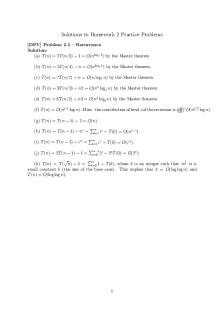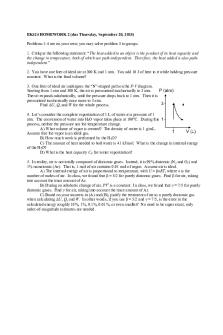8010 hw2 solutions PDF

| Title | 8010 hw2 solutions |
|---|---|
| Author | Sky Shepherd |
| Course | Microeconomics I |
| Institution | University of Georgia |
| Pages | 3 |
| File Size | 61.7 KB |
| File Type | |
| Total Downloads | 112 |
| Total Views | 178 |
Summary
ECON 8010 MicroEconomics I for PHD . Fall 2017. This is the assignment on Consumer and producer theory....
Description
Econ 8010 HW2 Solutions Nathan Yoder University of Georgia
Fall 2017 1. Consider a quasilinear utility function u : R+L × R → R given by u( x, m) = φ ( x ) + m Suppose that φ is twice continuously differentiable and strictly concave: its Hessian derivative matrix D2 φ ( x ) is continuous and negative definite for all x. (a) Express Walrasian demand for x as an implicit function of prices p and wealth w. • ∇ φ ( x ( p, w)) =
1 p L +1 p L .
(b) Express Hicksian demand for x as an implicit function of prices p and required utility level u. ¯ • ∇ φ (h( p, u¯ )) =
1 p L +1 p L .
(c) Use the implicit function theorem to compute the L × L Slutsky matrix for the L non-numeraire goods. (Hint: Negative definite matrices are invertible.) What has to be true about the Hessian derivative matrix D2 φ ( x ) for each of the L non-numeraire goods to be net substitutes? What about net complements? • From the implicit function theorem, D p L h( p, u¯) = 1
1 p L +1
( D2 φ (h( p, u¯ )))−1
So the inverse Hessian ( D2 φ (h( p,u¯)))−1 must have nonnegative off-diagonal elements for the non-numeraire goods to be net substitutes, and nonpositive off-diagonal elements for them to be net complements. 2. (exercise by Dan Quint1 ) Let u( x ) = x1α( x2 + x3 )1−α . (a) Is utility homothetic? What does that tell you about the change in Walrasian demand as wealth increases? • Homotheticity is pretty obvious. Thus, income effects do not depend on wealth. (b) If p2 > p3 , which goods will the consumer demand? If p3 > p2 ? • The consumer will demand the cheaper of x2 and x3 . (c) Solve the UMP and find Walrasian demand: i. when p2 > p3 x1 ( p, w) =
αw (1 − α ) w , x2 ( p, w) = 0, x3 ( p, w) = p1 p3
ii. when p3 > p2 x1 ( p, w) =
αw (1 − α ) w , x2 ( p, w) = , x3 ( p, w) = 0 p1 p2
iii. when p2 = p3 x1 ( p, w) =
(1 − α ) w αw , x2 ( p, w) + x3 ( p, w) = p1 p3
(d) Solve the EMP and find Hicksian demand: i. when p2 > p3 h1 ( p, u¯) = u¯
1− α
, h2 ( p, u¯ ) = 0, h3 ( p, u¯) = u¯
1− α
(1 − α ) p 1 , h2 ( p, u¯) = u¯ αp2
αp3 (1 − α ) p 1
(1 − α ) p 1 αp3
α
ii. when p3 > p2
αp2 h1 ( p, u¯) = u¯ (1 − α ) p 1 1I
have added part (d) to the original exercise.
2
α
, h3 ( p, u¯ ) = 0
iii. when p2 = p3 h1 ( p, u¯) = u¯
αp3 (1 − α ) p 1
1− α
(1 − α ) p 1 , h2 ( p, u¯) + h3 ( p, u¯ ) = u¯ αp3
α
(e) Compute the indirect utility function v( p, w) and the expenditure function e ( p,u¯). v( p, w) = w e ( p, u¯ ) =
α α (1 − α )1 − α , p1α (min{ p2 , p3 })1−α
up ¯ α1 (min{ p2 , p3 })1−α
1−α α
α
+
α 1−α
1− α !
3. A consumer has Cobb-Douglas utility u( x1 , x2 ) =
2 1 log x1 + log x2 3 3
and wealth w = 18. Suppose prices change from ( p1 , p2 ) = (1, 2) to (3, 1). (a) What is her consumption bundle at the original price vector? How much utility does this yield? How much wealth will she need to afford her old consumption bundle after the price change? • Original bundle=(6, 6), Utility=log 6, w′ = 24 (b) Calculate the (total, not infinitesimal) Slutsky substitution effect of the price change. • Demand at w′ = 24 and p = (3, 1) is (38, 16). So Slutsky effect is (− 10 3 , 10) (c) Calculate the (total, not infinitesimal) Hicks substitution effect of the price change. • We calculated Cobb-Douglas Hicksian demand in (2). So Hicksian demand at u¯ = log 6 is (61/3, 64/3 ). So Hicks effect is (61/3 − 6, 64/3 − 6).
3...
Similar Free PDFs

8010 hw2 solutions
- 3 Pages

HW2 solutions
- 6 Pages

Hw2 practice solutions
- 2 Pages

Hw-2 sol - hw2 solutions
- 7 Pages

EK424 HW2+solutions - Fall 2018
- 6 Pages

6414 HW2 Peer Solutions SP2021
- 9 Pages

Hw2 solutions - hw 2 solu
- 4 Pages

HW2 Fin305 - HW2
- 3 Pages

Hw2 solution - hw2
- 5 Pages

HW2
- 12 Pages

HW2 - gfhfghfgh
- 4 Pages

Hw2 solution
- 5 Pages

HW2 solution
- 19 Pages

HW2-sol
- 2 Pages
Popular Institutions
- Tinajero National High School - Annex
- Politeknik Caltex Riau
- Yokohama City University
- SGT University
- University of Al-Qadisiyah
- Divine Word College of Vigan
- Techniek College Rotterdam
- Universidade de Santiago
- Universiti Teknologi MARA Cawangan Johor Kampus Pasir Gudang
- Poltekkes Kemenkes Yogyakarta
- Baguio City National High School
- Colegio san marcos
- preparatoria uno
- Centro de Bachillerato Tecnológico Industrial y de Servicios No. 107
- Dalian Maritime University
- Quang Trung Secondary School
- Colegio Tecnológico en Informática
- Corporación Regional de Educación Superior
- Grupo CEDVA
- Dar Al Uloom University
- Centro de Estudios Preuniversitarios de la Universidad Nacional de Ingeniería
- 上智大学
- Aakash International School, Nuna Majara
- San Felipe Neri Catholic School
- Kang Chiao International School - New Taipei City
- Misamis Occidental National High School
- Institución Educativa Escuela Normal Juan Ladrilleros
- Kolehiyo ng Pantukan
- Batanes State College
- Instituto Continental
- Sekolah Menengah Kejuruan Kesehatan Kaltara (Tarakan)
- Colegio de La Inmaculada Concepcion - Cebu

